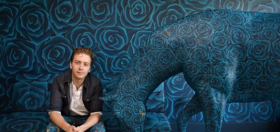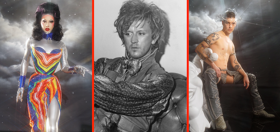
Longtime survivor Jim Chud agreed to share his incredible story of survival with Queerty
This December 1st, World AIDS Day, marks the beginning of my 40th year of living with HIV. I use this day as the ceremonial start/finish for each year because it was in November of 1977 that I entered Yale’s student infirmary with a gang of symptoms – night sweats, swollen lymph nodes, a low-grade fever, rash, thrush, and feeling like I had the flu. Today, if I walked into a doctor’s office with all of that going on, I’d be having my mouth swabbed and someone with a long face would be asking if I was gay and telling me about ‘seroconversion’ and how HIV is no longer a death sentence.
While the trajectory of AIDS has changed immensely, I think that knowing my tendency for feeling invincible until something happens to me, there is great peril that the current generation will never know how terrible the AIDS epidemic has been in gay America, let alone the the rest of the world.
When I was 23, I walked into my friend Jerry’s hospital room to find the guy I had been on a backpacking trip on the Appalachian Trail a month earlier in a steamed-up oxygen tent, struggling for each painful breath. He had pneumocystis pneumonia. He motioned me to come into the tent so that we could talk. Scared, I looked around the room for reassurance that I wasn’t going to hurt him if I did. A nod from his lover, and I was in the steam, touching his skeletal sticky ‘old person’ hand and bawling my eyes out. After what seemed like way too little time holding each other, he gasped: “Don’t let this thing get you Jimbo,” and he dozed off. Can you imagine – this man was on his death bed, and he was worried about me. The humanity of that moment has never left me.
How about we take this to the next level?
Our newsletter is like a refreshing cocktail (or mocktail) of LGBTQ+ entertainment and pop culture, served up with a side of eye-candy.
That was the day that AIDS got real.
After seeing AIDS boil the muscle off every other man I knew before they died, I decided to get as much muscle on my frame as humanly possible. I got big – really big, and went to great lengths to get the steroids necessary to facilitate this. I crested at a lean but puffy 280 pounds. I must admit that in gay society being the big muscle guy in the crowd came with certain perk. The gym and the drugs – steroids are mood altering addictive drugs – became my refuge as more and more of my friends were getting sick and dying.
In 1987, I went out to the NIH and volunteered for the clinical trials that were just starting. With the trials, I figured that if, as was most likely to happen, the drug in my study was a clunker, then at least I had helped to eliminate something that was a waste of time. If it was “the cure,” or at least something that slowed the infection, then I had hit the jackpot. I never thought that what happened was a possibility.
Funding for AIDS research was not yet coming from the government, it was coming from the pharmaceutical companies and, in their desperation to be the first to find the magic bullet, they were putting chemicals into human trials that had no business being given to us. It was the old case of “will the drug kill the virus and spare the host or vice versa?” In those days, many viewed people with AIDS, especially if they were gay, as disposable.
When I walked into the waiting room of the 10th floor clinic and looked around the room, I was shocked at what I saw. Every seat in the room was occupied by people who looked like they were at death’s door. I didn’t realize how close I would grow to many of them in a short while. After suffering the same side effects as the other participants which I can only describe as gross, I found myself in the NIH hospital, all my joints were bright red, swollen and frozen. I spent about 4-5 days completely paralyzed, and after examining me, the director of the National Cancer Institute at NIH said, “Now Jim, if you can just get past this side effect, the virus just hates this drug.” I reminded him of how this wasn’t the quality of life promised at the beginning of the study, and he reluctantly took me off the study.
Today, I am the study’s sole survivor.
There have been consequences. I was told that the early treatment DDC had caused my immune system to attack my cartilage. Sadly, this process, and my drive to exercise and play the sports that I enjoyed, resulted in the destruction of all my cartilage. I am 7 inches shorter than I was when I entered that NIH study, as I have no disks, and after over 80 operations dealing with my condition over the last 13 years, I now depend on a 4-wheeled walker to get around.
I write this now for two reasons. I think that it is high time pharmaceutical companies like Roche, whose study drugs damaged people’s lives, to be responsible for what they did in the interest of making the billions of dollars that AIDS medications bring to these companies. I hope that anyone else still out there, not killed in other studies, speaks up and out.
My other hope is that, through reading my story and others, that our next generation learns about the horrors that await them if they lower their guard.
I am a very lucky man. I am sure that there are many things that have contributed to my longevity, and I think that my God-given purpose to educate others is primary among them.
But mostly, after 40 years of survival, my simple hope is that we all learn to be kinder to each other.




















ChrisK
That is incredible. Talk about defying the odds. I can’t believe that Roche wasn’t liable for doing that.
Baba Booey Fafa Fooey
Good for him. Glad you’re still with us.
ErikO
Congratulations.
ChrisK
@ErikO: Fuck you. What an asshole thing to say you POS.
asby
So how did he survive? By doing drugs and working out?…Clearly there has to be something genetic that has allowed him to live… While some guys die in 6 months
corktownboy
I love hearing good news stories and the notation that he wishes us to be kinder. Bravo – kinder and gentler are the better way to be. Thank you for sharing your life story. Inspirational.
TTTTom
Saying he’s a very lucky man is a gross understatement; he’s a hero. He went into the NIH and volunteered for clincal trials in 1987 when AZT was still being used to kill us. For the record, I ran.
To this day, if AIDS doesn’t kill you, the HIV drugs will.
Speaking up about the damage done by study and other drugs is worthy but holding the pharmaceuticals accountable is nearly impossible. Before participating, most of us had to sign more release forms and documents than we did to enlist or get a mortgage. Case in point: How many people, or heirs, received anything from Merck for the heart attacks Isentress gave them?
I’m pretty sure HIV was invented and spread to identify us. The pharmaceuticals, to finish us off.
Jim Chud doesn’t say so directly but a common denominator among LTSs is pot use. I wouldn’t necessarily ascribe his longevity to it but it’s unquestionably a benefit.
toronto
What, this guy wants a parade? Please.
Heywood Jablowme
@TTTTom: “a common denominator among LTSs is pot use. I wouldn’t necessarily ascribe his longevity to it but it’s unquestionably a benefit.”
I’ve noticed that too. Don’t know if there are studies on that one.
@TTTTom: “To this day, if AIDS doesn’t kill you, the HIV drugs will.”
To this day? Seriously? No.
ChrisK
@toronto: He happens to be in a parade dipshit. Now go troll somewhere else.
Ander
@toronto: at no point in the article did this man state or imply that he wants “a parade.”
You’re really quite the horse’s ass, however.
n900mixalot
What a beautifully-written piece. I bet this guy has some fantastic stories to tell and has lived a full life. The last line clinches it too.
Thanks!
Jack Meoff
Someone needs to collaborate with this man on a biography his would be a tale worth telling.